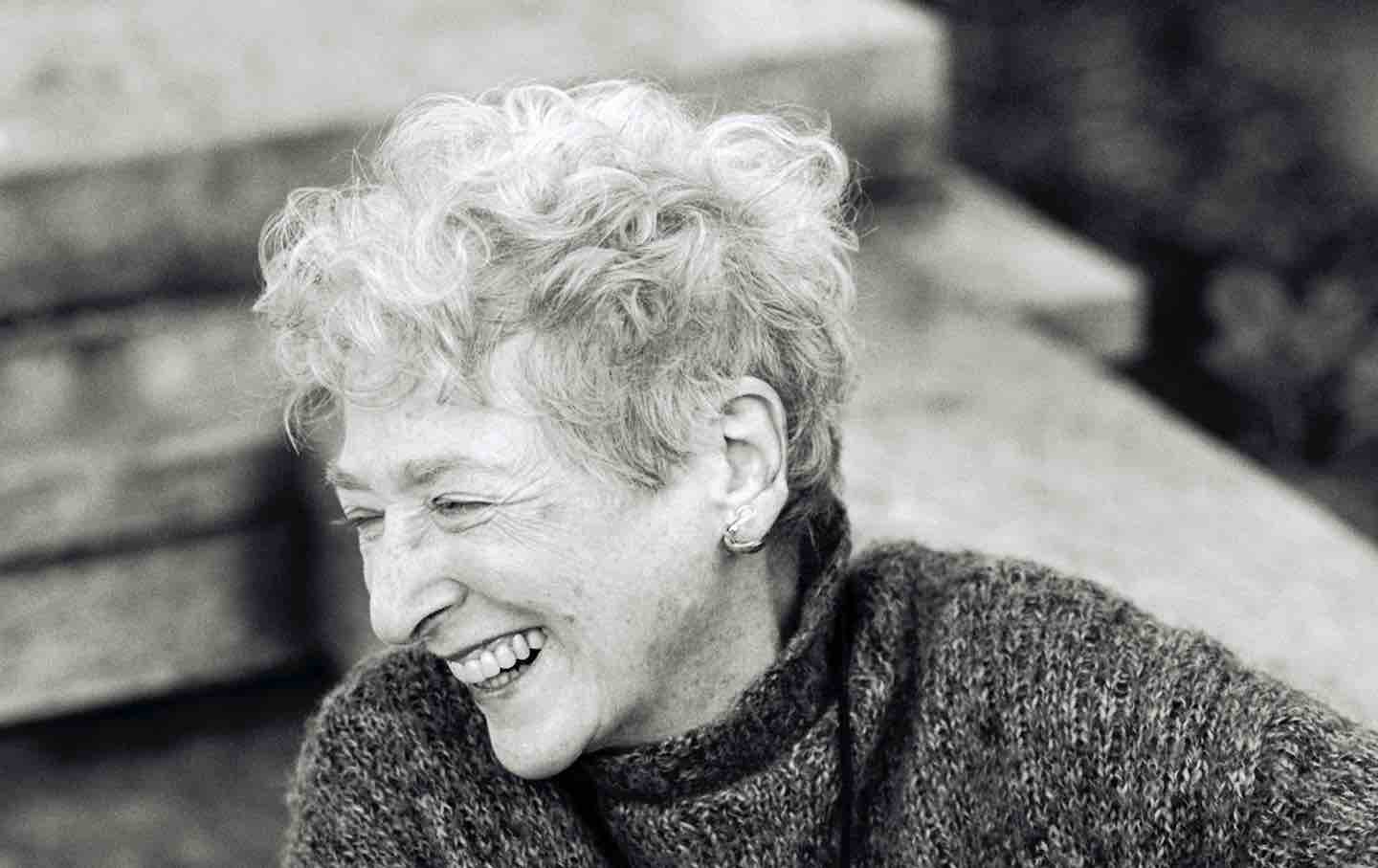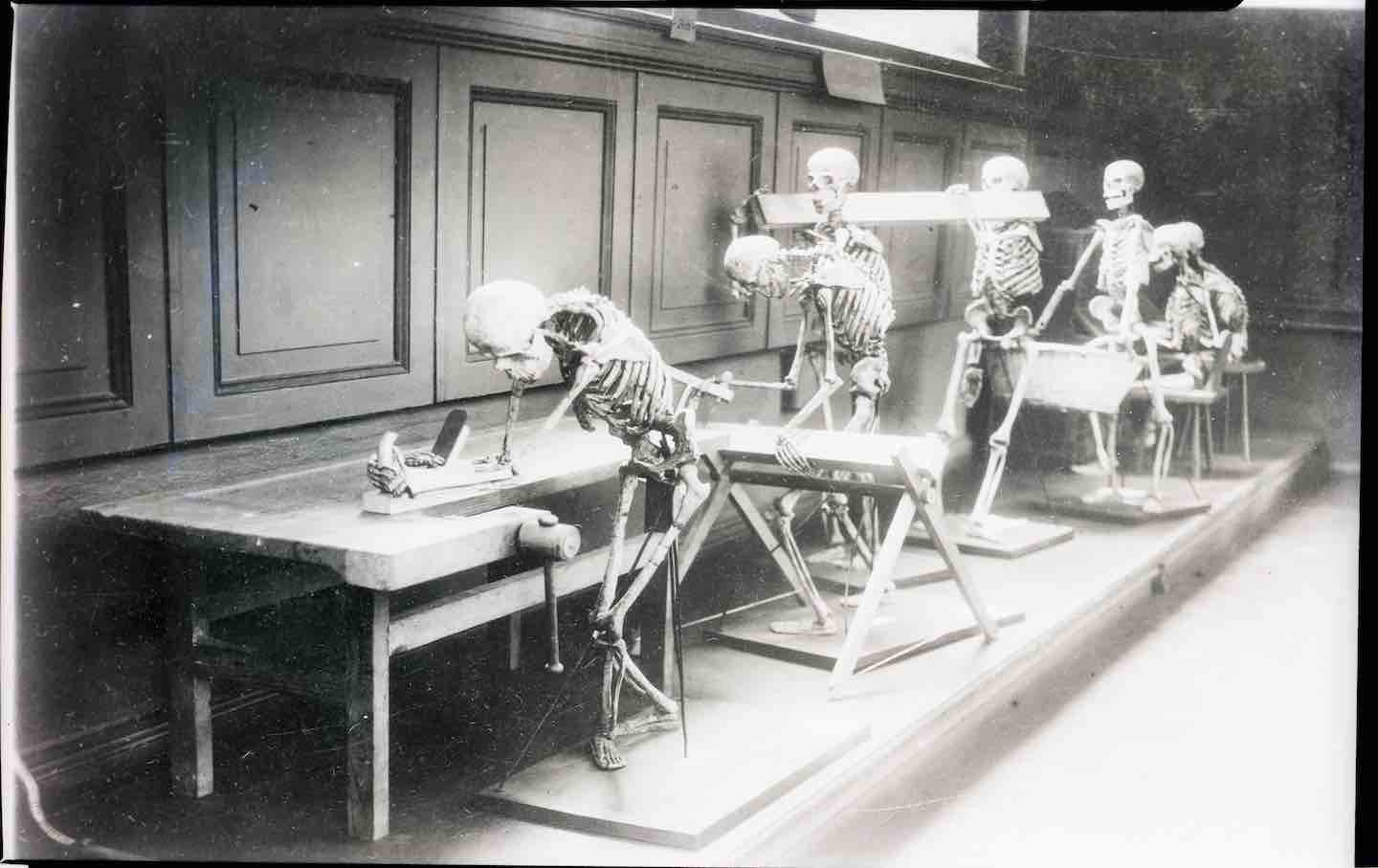Lore Segal’s Stubborn Optimism
In her life and work, she moved through the world with a disarming blend of youthful curiosity and daring intelligence.

Lore Segal.
(Ellen Dubin)
Is it inevitable that all children outgrow their precociousness? I started to puzzle over this question while reading the works of the Austrian writer Lore Segal, who died in October at 96 years old, and I realized that perhaps we should not think of precocity as a phase but as a style—one that can be exhibited at any age. Until the very end of her life—until the very week of her death—Segal wrote and published novels and stories with the disarming blend of youthful curiosity and daring intelligence that was a hallmark of her work since the beginning of her writing career.
Books in review
-
Ladies’ Lunch: And Other Stories
Buy this book -
Tell Me a Mitzi
Buy this book
It was a career that began very early. Born in Vienna in 1928, she was sent at the age of 10 on an experimental train called the Kindertransport, used to evacuate Jewish children from Nazi-occupied territories to refugee camps in Britain, where they were paired with foster families. Sent into the world alone, Segal was given instructions to begin a letter-writing campaign to her aunt and uncle in London, in hopes that they could help her to secure visas for her parents. An uncommonly talented person from a young age, she succeeded in this, writing a letter moving enough to compel a refugee aid organization to sponsor her parents, which helped them reunite with their child and survive the Second World War.
I knew all of this before I read Segal’s autobiographical novel Other People’s Houses, published in 1964, which tells the story of her forced migration from Europe and the years of itinerancy that followed. The facts would suggest a tone of awestruck solemnity, the kind in which Holocaust stories are often told. I had imagined an intelligent child, someone aware of her extraordinary and existential responsibility, bringing all of her talent, heartfelt feeling, and determination to bear on the writing project that would save her family. I was unprepared, when I finally read the book, for how Segal actually describes embarking on this overwhelming assignment. Ten-year-old Lore has just arrived in a refugee camp in England, populated by children who have left their families behind, and on her way back from her first breakfast in the dining hall, she comes upon a rosebush covered in snow. Segal writes:
I was a symbolist in those days, and roses and the like were just my speed. It excited me. I would write it in a letter to Onkel Hans and Tante Trude in London, saying that the Jews in Austria were like roses left over in the winter of the Nazi Occupation. I would write that they were dying of the cold. How beautifully it all fell into place! How true and sad! They would say, “And she is only ten years old!” I ran around the cottage and up the veranda steps. I emptied my rucksack onto the blanket, looking for pen, paper, and my father’s list of addresses with a rapidity that matched the rate at which my metaphor was growing and branching. I wanted to be writing.
As Segal said, decades later, in an interview with Bomb, “I tell my writing students: The one thing you can rely on in any situation is that the feelings you’re going to have are not the ones you think you’re supposed to have. Look and see what’s really going on.” In her own story, at this moment of unfathomable responsibility, Lore still cannot help but feel excitement at the act of writing. Instead of robbing her of her childlike playfulness, this moment forced Segal to forge it into something durable that she could carry through life. In Other People’s Houses, she is an alert and willful young girl, which gets her into trouble with the strangers whose homes she lives in and whose generosity she relies on. “That child!” one says of her. “She’ll argue the hind legs off a donkey!” Yet the pleasure she finds in using her mind is how she survives. She walks through the world alone, “writing mental letters” and then “tast[ing] the delicious phrases” of her prose when she thinks back on it. Even the horrors of her childhood she recalls writing about “with gusto.”
In an essay in The New York Review of Books, Segal’s friend Vivian Gornick quotes her as saying something that has been repeated so often that it has become nearly synonymous with her literary project: “In that moment I realized I’d decided to give up grief, and go for interesting.” It makes sense that this theme persists: Her fiction works because of its openness, its nonjudgmental stance on the material of life. Guided by “interest,” Segal is not scared off by pain. Still, I feel that it misses something about how it feels to read her. To find something “interesting” feels nearly sociological in its neutral detachment, and Segal was certainly not detached. For her, to take interest in something was to participate in it, to find a way to delight in it.
I’d argue instead that an irrepressible gusto is the skeleton key to Segal’s body of work, in which the turmoil of the past century was metabolized into an ars poetica. The pleasures of writing and language always lie at the center—embodied by the excitable intellects of her characters, and by a mischievous sense of humor that appears on just about every page of her books. In the same interview with Bomb, she said, “It’s that fascination, delight, and thrill with one’s own capacity to make words hold an idea that, I think, is knowing you are a writer.” Segal made this thrill palpable in her fiction.
Her protagonists are all, like their author, Jewish refugees in America who greet the unfamiliar with effervescent and unending curiosity rather than alienation. In her essay, Gornick locates this quality in one of “Lore’s tendencies,” which is “beginning a sentence with ‘Why do you think it is that…’ Fill in the blank. Why do you think it is that people hate being corrected? Why do people feel ignored when a speaker at the table doesn’t look at them? Or humiliated when someone they’ve met doesn’t remember meeting them?” Segal’s mind was like a mouth that wouldn’t stop watering, in constant search of something to sink its teeth into.
Her body of work also occupies one interconnected fictional world, in which the same characters pop up again and again, creating a feeling of fond familiarity in the reader who follows Segal from book to book. In Other People’s Houses, Lore the character takes a creative-writing class and meets a Black intellectual named Carter Bayoux. In Her First American, Ilka Weissnix, who is markedly, if only fractionally, different from the character Lore, has a sexual and intellectual affair with Bayoux, one formed around her wish to learn everything there is to know about America. Lucinella, Segal’s wonderfully raucous 1976 novella, opens at Yaddo, where one of the residents is a poet named Winterneet. Thirty years later, in Shakespeare’s Kitchen, a book of linked stories from 2007, Winterneet has won a Nobel Prize and become a fellow at the university institute where Ilka has just taken a job. In Ladies’ Lunch, Segal’s final book, published in 2023, a group of nonagenarian women get together every month, as they’ve been doing for decades, and talk about their lives and their latest observations. In the collection’s later stories, the ladies invite Ilka and Lucinella to join. Just as the women in the Ladies’ Lunch group choose to examine all of life’s questions with one another, Segal saw no shortage of what she might be able to access or discover with this one small cast.
By interconnecting her novels’ worlds this way, Segal created a feeling of intimacy and community across her body of work—a feeling that her dislocated characters repeatedly express desire for. In Shakespeare’s Kitchen, Ilka finishes a conversation with two new acquaintances by asking them, “Will you be my elective cousins?…. I’m low on the kind one has by blood.” In Her First American, a younger Ilka, on a trip to the country with Carter and a few other couples, announces, “I like it so much to see old friends talking together…. I traveled so much to and fro Europe I have always lost all my friends again.” In her fiction, Segal offers her reader the fulfillment that she wished for in life.
There is an acute sense of seeking, and finding, fulfillment in Segal’s fictional world, which sharpens both the pains and the joys. At the end of Other People’s Houses, Segal takes stock of the ease and pleasures of her life in New York (“every day there are hours when I can write, and we have our friends”). Her American husband, she says, “accepts without alarm this normal season of our lives; but I, now that I have children and am about the age my mother was when Hitler came, walk gingerly and in astonishment upon this island of my comforts, knowing it is surrounded on all sides by calamity.”
Time gave this passage new poignancy: Six years after the book’s publication, Segal’s American husband, David, died suddenly of a heart attack, leaving her to raise their two children alone. Yet her sense of astonishment appears undimmed in later works; loss seems to have lent it a new urgency. Perhaps what I’ve identified as Segal’s precocity was a refusal to let her intelligence and powers of observation be constricted by cynicism, even in the face of tragedy. Her curiosity partook of a stubborn optimism.
For Segal’s characters, intelligence is inseparable from a hunger for experience, a quality that the writer Han Ong has described as Segal’s “avidity.” Segal’s characters love to talk; they are always engaged in big, lively conversations. (In Her First American, Ilka’s wonder and puzzlement at American speech and idiom reflects that of Segal, who writes with a magnificent sense of precision and fun. At one point, she describes Carter’s sleeping breath as “a necklace of little farts.”) They find sensual and intellectual satisfaction in their interpersonal relationships, friendly as well as romantic. The first love scene between Carter and Ilka begins with Carter telling her to take off her blouse. “‘I have always wondered before how people come to have taken their blouses off,’ chattered Ilka. ‘I always wondered how the bed has become open.’” In Shakespeare’s Kitchen, when Ilka and Leslie Shakespeare, one of her “elective cousins,” begin a secret affair (a recurring feature of Segal’s work), he insists, “One must live, to live.”
Segal was a writer who lived on the page, really lived, joyfully and infectiously. And this spirit did not depend on her perceiving things selectively or sentimentally and then filtering out the rest. Pleasure for Segal came from her interest in the world as it is. Carried through Her First American by Ilka’s avidity and her own sense of humor, Segal was able to write about race in America in a way that few white writers of her generation dared to, looking closely at the insults and indignities that Black people in America face. And Ilka is not spared; she is portrayed as naïve but not as innocent. At one point, she asks Carter why a young white woman they know married her older Black husband and then stops herself, realizing the implications of what she is saying.
Popular
“swipe left below to view more authors”Swipe →“You think I mean that?” cried Ilka.
“What did you mean?”
“That!” said Ilka with the thrill of revelation. “I’m a racist!”
“Not to worry,” Carter said. “Some of my best friends are racists.”
Another aspect of the avidity of Segal’s characters is their constant desire to be told stories by other people. In reading her body of work, I understood the meaning of this request in a new way. Coming from Segal, “Tell me a story”—the refrain of a precocious child—is not a wish to be comforted or put to bed but a demand for access to more life, however brutal. I appreciated, suddenly, the fearlessness it takes to maintain a childlike hunger for the world.
It is little surprise, then, that Segal also directed her playful imagination toward children’s literature. Her first children’s book, Tell Me a Mitzi, published in 1970 and reissued this past summer by New York Review Books, starts with the line “Tell me a story,” spoken by a child named Martha to her mother. Her mother invents a story about a little girl named Mitzi taking her baby brother out on an independent adventure in New York—taking the elevator, hailing a cab. The story offers Martha a feeling of freedom, or even danger, within the experience of safety, as good stories do, and in the two remaining sections of the book, she increasingly demands more.
“Tell me a Mitzi,” said Martha.
“Later I will,” said her mother. “Now I’ve got a headache.”
In a little while Martha asked her mother, “Mommy, now is it later?”
“No,” said her mother. “It’s still now.”
It was in Segal’s late work that her precocity reached its unlikely climax. Nearing 90, she started writing the series of stories that became the book Ladies’ Lunch. The worlds of Segal’s characters had grown smaller and more confined—one story ends with the line “Who said that wakes and funerals are the cocktail parties of the old?”—but she brought the full force of her curiosity to the transformations and degradations of old age, a foreign land to all who reach it.
Ladies’ Lunch is an achievement of late style, a chronicle of an experience—aging and dying—that we rarely see discussed and analyzed with so much personality and self-possession. In the story “The Arbus Factor,” a man named Jack and a woman named Hope go to lunch and reminisce about a trip to France they took long ago, before they married other people. They fantasize about returning and wonder together what’s to stop them. Then there’s a turn: “There were a lot of reasons, of course, to keep them from going back,” Segal writes, shifting suddenly to the points of view of their grown children, as Jack’s son enters the restaurant “on his way to the corner where, an hour ago, he had folded up his father’s wheelchair.” This moment comes as a shock—to see Jack and Hope as the world sees them, after seeing them the way they see themselves.
The relationship among the women of Ladies’ Lunch is one of intellectual fellowship, and each gathering has a conversational “agenda”—a subject the women want to mine together for meaning or understanding. This group is apparently based on a real one, but the characters feel more like refractions of Segal’s distinctly avid literary mind than like particular individuals. The first line of dialogue spoken in the book is this: “You remember that we are the people to whom we tell our stories? Well, I have a story for you.” Later in the book, another woman echoes the same idea: “When I suddenly sat on my rear on the sidewalk outside my front door, I was looking forward to telling you.” They talk about death, illness, and the loss of their faculties or autonomy—nearly unbearable subjects to contemplate, were it not yet again for the pleasures of thinking. When someone asks a good question, the others respond by “brightening,” or with “interest” that “pricked right up.” In the titular story, a woman named Lotte won’t put up with the full-time caregivers her sons have hired, so they plan to move her to an assisted-living facility in the Hudson Valley. At lunch, in response to Lotte’s unhappiness, the ladies discuss “the scenarios we would rather die than live in.”
“And it was you,” a woman named Farah says to Lotte, “who said you wanted to see it all, to see what would happen to the end.”
What happens at the end was one of Segal’s key and long-standing preoccupations as a writer: the way that time takes away the world as we love it. She closed not one but three of her novels with a rapid acceleration into the future, delivering the reader to a time when many of the book’s characters have died and the story we were absorbed in has become a memory. As in life, we are left in a state of mourning.
But in Ladies’ Lunch, loss does not belong to a faraway time. The present has been made crystalline by its fragility, and though the end may be indeterminate, it feels near. In the last story of the collection, we see the women in Covid quarantine, holding their lunch meeting over Zoom. They are “sitting around telling Lotte stories,” as one of them puts it, to honor their late friend. They ask themselves why they can’t bear to delete the contact information of a person who has died, and Ilka describes old photographs that she brought over from Austria, which she won’t discard even though she does not know the people who appear in them. The women muse together about the “idea of the sacred” in human beings and the “enigma” of “being erased.”
Then the final line to Segal’s final book: “And then their forty minutes were up.”
To the last, Lore Segal was a writer who was alive to the poetry of the present moment—a writer who never turned away from the world.
What’s more, it seems like this quality was palpable in every interaction she had. So much writing that has been published about Segal’s work also spoke to her presence and personal magnetism, which bewitched her many interlocutors. Because I’m lucky enough to have been one of them, I can’t help but fall into this pattern. Last spring, I went up to her Upper West Side apartment (where she had lived, she told me, since the day of John F. Kennedy’s inauguration), clamped a microphone to her desk, and recorded her reading a new piece of writing aloud. Midway through the story, she told me that she was getting tired, that she needed to take a break. She was losing her sight and had to strain to follow the words on her screen. With a small movement, she batted the microphone away from her face, sending it swinging on its long metal arm, and then leaned back in her chair, turned to me, and with a wonderful look of repose said, “Tell me a story.”
We cannot back down
We now confront a second Trump presidency.
There’s not a moment to lose. We must harness our fears, our grief, and yes, our anger, to resist the dangerous policies Donald Trump will unleash on our country. We rededicate ourselves to our role as journalists and writers of principle and conscience.
Today, we also steel ourselves for the fight ahead. It will demand a fearless spirit, an informed mind, wise analysis, and humane resistance. We face the enactment of Project 2025, a far-right supreme court, political authoritarianism, increasing inequality and record homelessness, a looming climate crisis, and conflicts abroad. The Nation will expose and propose, nurture investigative reporting, and stand together as a community to keep hope and possibility alive. The Nation’s work will continue—as it has in good and not-so-good times—to develop alternative ideas and visions, to deepen our mission of truth-telling and deep reporting, and to further solidarity in a nation divided.
Armed with a remarkable 160 years of bold, independent journalism, our mandate today remains the same as when abolitionists first founded The Nation—to uphold the principles of democracy and freedom, serve as a beacon through the darkest days of resistance, and to envision and struggle for a brighter future.
The day is dark, the forces arrayed are tenacious, but as the late Nation editorial board member Toni Morrison wrote “No! This is precisely the time when artists go to work. There is no time for despair, no place for self-pity, no need for silence, no room for fear. We speak, we write, we do language. That is how civilizations heal.”
I urge you to stand with The Nation and donate today.
Onwards,
Katrina vanden Heuvel
Editorial Director and Publisher, The Nation
More from The Nation

The Perils of a Post-Racial Utopia The Perils of a Post-Racial Utopia
In Nicola Yoon’s One of Our Kind, a dystopian novel of a Black upper-class suburb’s secrets, she examines the dangers of choosing exceptionalism over equality.

Why Americans Are Obsessed With Poor Posture Why Americans Are Obsessed With Poor Posture
A recent history of the 20th-century movement to fix slouching questions the moral and political dimensions of addressing bad backs over wider public health concerns.

Thomas Müntzer’s Misunderstood Revolution Thomas Müntzer’s Misunderstood Revolution
A recent biography of the German preacher and leader of the Peasants’s War examines what remains radical about the short-lived rebellion he led.

Is It Possible to Suspend Disbelief at Ayad Akhtar’s AI Play? Is It Possible to Suspend Disbelief at Ayad Akhtar’s AI Play?
The Robert Downey Jr.–starring McNeal, which was possibly cowritten with the help of AI, is a showcase for the new technology’s mediocrity.

Possibility, Force, and BDSM: A Conversation With Chris Kraus and Anna Poletti Possibility, Force, and BDSM: A Conversation With Chris Kraus and Anna Poletti
The two writers discuss the challenges of writing about sex, loneliness, and the new ways novels can tackle BDSM.

The Sheer Gusto of Jane DeLynn The Sheer Gusto of Jane DeLynn
1982’s In Thrall was a magnificent piece of queer fiction, at once comic and courageous.


